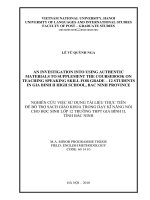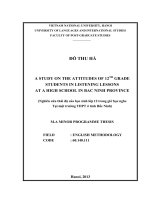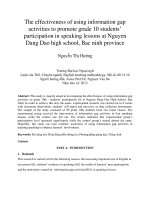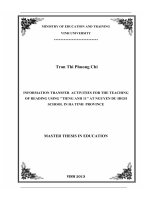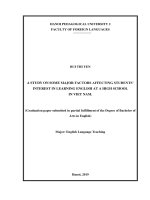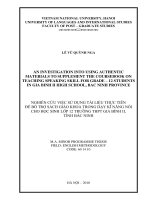A survey on the 10th graders using mobile phones in learning english at nguyen du high school, bac ninh province
Bạn đang xem bản rút gọn của tài liệu. Xem và tải ngay bản đầy đủ của tài liệu tại đây (1.27 MB, 70 trang )
VIET NAM NATIONAL UNIVERSITY OF AGRICULTURE
FACULTY OF EDUCATION AND FOREIGN LANGUAGES
BA THESIS
A SURVEY ON THE 10TH GRADERS’ USING MOBILE
PHONES IN LEARNING ENGLISH AT NGUYEN DU
HIGH SCHOOL, BAC NINH PROVINCE
(KHẢO SÁT VIỆC SỬ DỤNG ĐIỆN THOẠI DI ĐỘNG
TRONG VIỆC HỌC TIẾNG ANH CỦA HỌC SINH
LỚP 10 TẠI TRƯỜNG THPT NGUYỄN DU,
TỈNH BẮC NINH)
Student
: NGUYEN THI BICH NGOC
Student code
: 621208
Class
: K62ENGA
Major
: ENGLISH
Supervisor
: NGUYEN THI THU THUY, Ph.D
Hanoi – 2021
VIET NAM NATIONAL UNIVERSITY OF AGRICULTURE
FACULTY OF EDUCATION AND FOREIGN LANGUAGES
BA THESIS
A SURVEY ON THE 10TH GRADERS’ USING MOBILE
PHONES IN LEARNING ENGLISH AT NGUYEN DU
HIGH SCHOOL, BAC NINH PROVINCE
(KHẢO SÁT VIỆC SỬ DỤNG ĐIỆN THOẠI DI ĐỘNG
TRONG VIỆC HỌC TIẾNG ANH CỦA HỌC SINH
LỚP 10 TẠI TRƯỜNG THPT NGUYỄN DU,
TỈNH BẮC NINH)
Student
: NGUYEN THI BICH NGOC
Student code
: 621208
Class
: K62ENGA
Major
: ENGLISH
Supervisor
: NGUYEN THI THU THUY, Ph.D
Hanoi – 2021
CERTIFICATE OF ORIGINALITY
I, the undersigned, hereby certify my authority of the study project report
entitled A SURVEY ON THE 10TH GRADERS’ USING MOBILE PHONES
IN LEARNING ENGLISH AT NGUYEN DU HIGH SCHOOL, BAC NINH
PROVINCE submitted in partial fulfillment of the requirements for the degree
of Bachelor in English Language. Except where the reference is indicated, no
other person’s work has been used without due acknowledgement in the text of
the thesis.
Hanoi, 2021
Nguyen Thi Bich Ngoc
Approved by
SUPERVISOR
(Signature and full name)
Date:……………………
i
ACKNOWLEDGMENT
In the process of completing this research paper, I have received great
deal of helps, guidance and encouragements from teachers and friends. First of
all, I would like to express my deepest thanks to my supervisor, Ph.D Nguyen
Thi Thu Thuy who given me suggestions on how to shape the study and always
been most willing and ready to give me valuable advice, helpful comments as
well as correction of my research paper. Next, I would like to express my
gratitude to all teachers in Faculty of Education and Foreign language of
Vietnam National University of Agriculture that help me much in completing
this paper.
Although many efforts have been made during the implementation of the
thesis, there may be limitations and shortcomings. I look forward to receiving
comments and guidance from teachers and friends.
ii
TABLE OF CONTENTS
CERTIFICATE OF ORIGINALITY ..................................................................... i
ACKNOWLEDGMENT ....................................................................................... ii
TABLE OF CONTENTS ..................................................................................... iii
LIST OF TABLES ................................................................................................ v
LIST OF FIGURES .............................................................................................. vi
ABSTRACT ........................................................................................................ vii
PART I: INTRODUCTION ................................................................................. 1
1.
RATIONALE FOR THE STUDY ............................................................ 1
2.
AIMS AND OBJECTIVES OF THE STUDY ......................................... 2
3.
RESEARCH QUESTIONS ...................................................................... 2
4.
SCOPE OF THE STUDY ......................................................................... 3
5.
SIGNIFICANCE OF THE STUDY ......................................................... 3
6.
DESIGN OF THE STUDY ....................................................................... 3
PART II: DEVELOPMENT ................................................................................. 5
CHAPTER 1: LITERATURE REVIEW .............................................................. 5
1.1.
REVIEW OF THE PREVIOUS STUDIES .............................................. 5
1.2.
REVIEW OF THEORETICAL BACKGROUND ................................... 7
1.2.1. Definition of mobile phones ..................................................................... 8
1.2.2. Impacts of using mobile phones on students’ learning English ............... 8
1.2.3. Advantages and disadvantages of using mobile phones on students’
learning.................................................................................................... 10
1.3
SUMMARY ............................................................................................ 13
CHAPTER 2: METHODOLOGY ...................................................................... 14
2.1.
RESEARCH QUESTION REVISITED ................................................. 14
2.2.
RESEARCH SETTING .......................................................................... 14
2.3.
RESEARCH METHODS ....................................................................... 14
2.4.
RESEARCH INSTRUMENTS ............................................................... 15
iii
2.5.
SUMMARY ............................................................................................ 16
CHAPTER 3: FINDINGS AND DISCUSSION ................................................ 18
3.1.
FINDINGS .............................................................................................. 18
3.1.1. Finding from questionaire ....................................................................... 18
3.1.2. Finding from interview ........................................................................... 33
3.1.3. Finding from observation ........................................................................ 34
3.2
DISCUSSION ......................................................................................... 35
3.3
SUGGESTIONS ..................................................................................... 36
PART 3: CONCLUSION .................................................................................... 40
3.1
RECAPITULATION .............................................................................. 40
3.3
LIMITATION OF THE STUDY ............................................................ 40
3.4
RECOMMENDATIONS ........................................................................ 41
PART 4: REFERENCES .................................................................................... 42
APPENDIX ........................................................................................................ 45
iv
LIST OF TABLES
Table 3.1: Frequency of accessing social networking sites by students ............. 21
Table 3.2: Student's assessment of the usefulness of using mobile phones
to learn foreign language. ................................................................... 22
Table 3.3: Student's assessment of the effectiveness of using mobile
phones to learn English. ...................................................................... 30
Table 3.4: Students' desire in teaching and learning English. ............................. 32
v
LIST OF FIGURES
Figure 3.1: Student's mobile phone usage time in non-academic activities ....... 18
Figure 3.2: Non-academic activities that students perform on mobile
phones .............................................................................................. 19
Figure 3.3: Students' habits of accessing social networking sites....................... 20
Figure 3.4: The duration of using mobile phones to learn English ..................... 23
Figure 3.5: Activities students frequently use
in learning English on
mobile phones .................................................................................. 24
Figure 3.6: Student access to English learning apps on mobile phones. ............ 26
Figure 3.7: Student access to English learning websites on mobile phones ....... 27
Figure 3.8: English skills students want to improve the most. ........................... 28
vi
ABSTRACT
In today's modern world, mobile phones have become inseparable from
human beings. We cannot deny that mobile phones have so many benefits,
especially in education. In learning English for students, mobile phones have
many applications and support tools such as websites and online learning
channels to help them learn English. This study attempts to discover and
investigates the current situation of using mobile phones in learning English
adapted by the 10th graders at Nguyen Du high school in Bac Ninh province.
The study describes the present educational situation of 10th graders use mobile
phones in learning English in class and outside of school hours. A questionnaire
survey, an observation, and an interview have been conceived and conducted on
120 students on the 10th graders of three classes 10A1 10A2, and 10A3. The
results from the analysis of the questionnaire, observation, and interview
represented that mobile phones in English learning in the classroom were still
restricted. Through the study, there are some suggestions to help students learn
English more effectively on mobile phones.
Keywords: mobile phone, current situation, learning English, the 10th
graders.
vii
PART I: INTRODUCTION
1. RATIONALE FOR THE STUDY
In recent years, mobile phones have been used popularly in people and we
cannot deny them benefits it in the educational system. While the first
generations of mobile phones did not offer much functionality beyond phoning
and text messaging, the newest 3G generation of mobile phones offers far
greater possibilities to suggest multimedia content, location-based learning
materials, and earnest games that elevate the learners’ enjoyment and
enthusiasm (Claudill, 2007).
With a mobile phone connected to the Internet or 3G, 4G, learners can
easily learn anytime, anywhere, find information what they want, regardless of
time or place. The learner is no longer constricted to learn at fixed locations. In
addition, the location where learning takes place can become an applicable part
of the learning context (Baldauf, et al. 2007). It is undeniable that children do
absorb in the classroom and casually out of the classroom. Their informal
experiences outside learning times at school may extend just as meaningful
learning opportunities as the structured learning environment established within
schools. For example, if you are travelling or at home, you can still study online
learning apps without the limitations of desktop computer technology. Even you
submit online papers if you cannot return in time or due to epidemics, you can
still contact the teacher via study management software such as MS team, Zoom.
Thornton and Houser (2003) pointed out that young Japanese students use
mobile phones for many activities, from emailing to reading books. Especially
in learning English, there is a more useful software to help students or even
employees can simply access and use them such as Duolingo, Native Talk.
Research on the use of mobile phones for the delivery of vocabulary materials to
English learners in Taiwan showed that learners were fond of using their phones
because it was easy to access materials and be able to practice anytime and
1
anywhere; in addition, some students enjoyed the screen size restrictions, which
made contents more manageably than that of other teaching materials (Chen, et
al. 2008).
As learning with a mobile phone is fundamentally different from
classroom learning, a new field of study has come into shape, namely that of
Mobile Learning (Sharples, 2000). Although there are many useful English
learning apps that you can learn from your mobile phone, the researches of
Vietnamese students' self-study of foreign languages based on mobile phones is
still relatively limited. That is why I chose the study “ A survey on the 10th
graders’ using mobile phones in learning English at Nguyen Du high school
in Bac Ninh province”.
Through questionnaires, interviews, and observations, this study pointed
to the current situation of the 10th-grade students at Nguyen Du High School,
Bac Ninh province using mobile phones to learn English and offered
suggestions to help students learn English more effectively.
2. AIMS AND OBJECTIVES OF THE STUDY
The aim of the study is to determine the current situation of using mobile
phones in learning English adapted by the 10th graders at Nguyen Du high
school in Bac Ninh province.
The objectives of the study are as follows:
- Investigating the current situation on the 10th graders’ using mobile phones in
learning English at Nguyen Du high school in Bac Ninh province.
- Making some suggestions to help students learn English better by using mobile
phones.
3. RESEARCH QUESTIONS
The study seeks to answer the following:
1. What is the current situation on the 10th graders’ using mobile phones
in learning English at Nguyen Du High School in Bac Ninh province?
2
2. What should be made suggestions so as to help the 10th graders of
Nguyen Du High School in Bac Ninh province learn English more effectively
via using mobile phones?
4. SCOPE OF THE STUDY
The study carried out at Nguyen Du High School in Bac Ninh province in
semester 2 of the school year 2020 – 2021 for 6 weeks from March to April in
2021. The Nguyen Du High School consists of 11 in grade 10 classes, but due to
limited research time and the Covid-19 epidemic, the scope of the study had to
conduct on 3 classes: 10A1, 10A2, and 10A3, about 120 students.
5. SIGNIFICANCE OF THE STUDY
The study of “Mobile phone usage in learning English” has been done not
just once. Conversely, different execution times and locations will gain different
results. Mobile phones have many benefits in supporting students' learning in
cities and provinces, but in Bac Ninh province, there has not been any research
on the application of mobile phones in learning English in particular and
learning in general. This is the first time that a research study has conducted
with grade 10 students at Nguyen Du High School in Bac Ninh province.
The results of the study showed the reality of using mobile phones in
English learning of grade 10 students at Nguyen Du high school, Bac Ninh
province. From there, we extracted the problems, gave solutions, appropriate
suggestions to improve the English learning of 10th graders better on mobile
phones.
6. DESIGN OF THE STUDY
Apart from abstracts, references & appendices, the study consists of three
main parts:
PART 1 - INTRODUCTION presents the rationale of the study, aims and
objectives of the study, research questions, the scope as well as the significance
of the study.
3
PART 2 - DEVELOPMENT is divided into 3 chapters:
Chapter 1 - LITERATURE REVIEW provides the theoretical background
for the study including definitions of mobile phones and outlines the impact of
cell phone use on high school students in general and English learning in
particular. Besides, this chapter gives some domestic and overseas studies
regarding the use of mobile phones in English learning.
Chapter 2 - METHODOLOGY describes the methodology used in the
research including the data collection instruments, participants, the procedures
employed to carry out the research.
Chapter 3 - FINDINGS AND DISCUSSIONS reports and discusses the
findings of the study.
PART 3 - CONCLUSION summarizes the main issues that have been
addressed in the study, points out the limitations and suggests several solutions.
4
PART II: DEVELOPMENT
CHAPTER 1: LITERATURE REVIEW
1.1. REVIEW OF THE PREVIOUS STUDIES
In Vietnam, there have been a number of studies on the use of mobile
phones in learning English, but no research topic has been found on the current
situation of using mobile phones in learning English among 10th graders.
Nguyen Xuan Nghia and many authors have conducted a study: "Students
and smartphones: use and effects on learning and social relations" (2017) at Ho
Chi Minh City Open University, have stated that to use mobile phones in a more
positive way for learning, we need to think about how does that create inequality
for poor students? What additional conditions must schools and society be
equipped with (for example, free and strong wifi?) What changes should be
made in the way of learning and teaching?. In order to know the actual situation
of students and teachers of Nguyen Du High School how to use mobile phones
in teaching and learning English at the school, the research has asked questions
in the questionaire, interview as well as observation related to the actual use of
mobile phones by students.
According to another study by Nguyen Thi Huynh Loc and Nguyen Thi
Phuong Thao with the topic: "The directions of technology application in
foreign language teaching." They also commented that most of the software for
applying IT in teaching is designed in a behavioral direction and teachers are
still not fully equipped with the knowledge to fully exploit the applications of IT
in the classroom foreign language teaching. That is why the survey on the actual
teaching and application of software by teachers and students in learning English
on mobile phones was carried out.
Regarding the research topic, Trinh Nguyen Thanh Truc, Nguyen Thi Ha,
Nguyen Thi Diem Suong of the Faculty of Social Sciences and Humanities in
the IX Student Scientific Conference - 2016 with the topic: "The effects of
5
smartphone use on student learning outcomes." pointed that the more mobile
phones are used for learning purposes, the higher the learning outcomes and the
more mobile phones are used for self-expression purposes, the lower the
learning outcomes and the reasonable use of mobile phones will help students'
learning results better. From the results of their study, it is shown that the use of
mobile phones has many benefits in learning in general, and in learning English
in particular, through the questions in the survey as well as in interviews. A
research paper with 10th grade students of Nguyen Du High School, Bac Ninh
province, surveying the access times and applications that students often use in
learning English as well as the activities students often do. on mobile phones
other than for learning purposes.
Abroad, there are a lot of investigations were conducted to understand
how mobile phones could be used to reach better education. A perusal of the
literature points largely to two different parties for the use of mobile phones in
education: advocates and opposers.
Thornton and Houser (2005) demonstrated three studies in mobile phone
learning. He has drawn that the students he studied, they felt using mobile
phones in the study as a valuable method and they appreciate the educational
efficiency in the classroom. For Kratcoski, stated that with the large expansion
of mobile technology, learning can transpire anytime and anyplace even if
teachers and students are not in the same physical or temporal location (Swan, et
al. 2007, p. 12). While Al Aamir, Kamla Suleiman claimed that the use of
mobile phones in the classroom is still limited. Students like to use them, but
teachers do not encourage them to do so fearing that this digital device will be a
bi distraction for both teachers and students alike. Also, despite the fact that
mobiles manifest themselves as a good learning tool, they still need to prove for
educationists, practitioners, teachers, and decision-makers that they are more
“saints”
than sinners in the educational field and classroom. They further
6
suggest that mobile phones are boons blessed if students only handle them (Al
Aamir & Kamla Suleiman. 2011).
The other studies come with the same view of the two standpoints,
Mcneal and Hooft indicated “using real world resources for teaching and
learning in the classroom can make education more meaningful and relevant to
our students” (Mcneal and Hooft, 2006, p.1). However, we cannot discover the
restrictions on the application of mobile phones in education.
There are quite many studies that outline and describe the drawbacks of
using mobile phones in education. Some abusers of mobile phones in education
call out to forbid mobile technologies from schools. For them, the use of mobile
phones in the study is a source of stimulation, delinquency, and even crime
(Katz, n.d.P.92). Also, “using mobiles in the classroom would end up causing
more distractions” and they just “intercept teaching” (cited in Katz p.94).
Thus, through domestic and international research, mobile phones are
increasingly used by the student community. Students use mobile phones for
many different purposes such as support learning, communication. The use of
mobile phones has both positive and negative effects on life, health, and learning
of students, especially for foreign language learning of school age. It is
necessary to find out the reality of using mobile phones in learning in general, or
learning English in particular so that we can find methods to improve the
effectiveness of using mobile phones.
1.2. REVIEW OF THEORETICAL BACKGROUND
The theory of choice behavior (George Homans, 1961) individual will
choose the action whose value of the result of that action and the probability of
achieving the result is greatest, for example, today's youth seem to find search
documents on mobile phones to serve for learning is more than finding in books
and newspapers. It seems that going to the library or going to a bookstore to find
7
study materials is quite time-consuming while finding documents online through
a mobile phone is very quick. What action will the individual choose?
The value of the result achieves the fastest and greatest effect. Students
can choose the type of mobile phone and how to use it to bring the best value to
them.
According to the theory of social action (Max Weber, 1958), a social
action is an individual's action that has some meaning. When individuals
perform an action, they will consider the behavior of others to guide their
actions. An action of which an individual is not conscious is not a social action.
Any action that does not take into account the possible reactions of others is not
a social act. The use of mobile phones by students is a social act because it is a
conscious, purposeful action.
Within the scope of this topic, the research team uses choice behavior
theory and social action theory to guide the research process and interpret
research results. First, we need to define some concepts.
1.2.1. Definition of mobile phones
“ Mobile telephone, also called a mobile phone, portable device for
connecting to a telecommunications network in order to transmit and receive
voice, video, or other data. Mobile phones typically connect to the public
switched telephone network (PSTN) through one of two categories: cellular
telephone systems or global satellite-based telephony” (David.E. Both, 2017).
1.2.2. Impacts of using mobile phones on students’ learning English
Vietnam is a promising country to develop learning trends in mobile
phones. They are still spreading an interesting and valid comment: when leaving
the house, the three items we cannot do without are wallet, keys and mobile
phone. The figures at the beginning of 2015 showed that, with a population of
more than 93 million, Vietnam currently has nearly 40 million internet users;
123.8 million mobile phone subscribers, about 32.4 million mobile phone users,
8
accounting for about 36% of the population. The percentage of people using
mobile phones increased rapidly: 36.5% in 2016 and 43.7% of the population
in 2017 (Kemp 2015). The telecommunications system is also developing
quickly while the cost of using it has decreased. These advantages have
created great opportunities for learning with the help of mobile phones,
especially in learning English.
Mobile phones are a useful means of support for students in learning a
foreign language. Using these applications may confirm that they could be effective
in terms of their learning experience as they are all about learning English,
particularly the skills which are used in the CLT classroom (Hockly, 2012).
In the way of teaching, in order to improve the effectiveness of teaching,
there was a study by Nguyen Van Long, University of Foreign Languages, the
University of Danang with the topic: "Application of information technology in
foreign language learning: From international experience to Vietnam" declared
that the process of applying IT to education in general and teaching foreign
languages in particular in the world is divided into three stages, namely: the
introduction of technology into the classroom (Introduction); the phase of
technology integration into the classroom (Integration); and the stage of
technology invisibility in the classroom (Invisibilisation). And most importantly,
We are following the world because "cannot read" means that in order to reach a
developed knowledge economy like in the world, those who work in teaching
and imparting knowledge must understand the technology and apply technology
in teaching in a flexible way to achieve the best learning effect for students. In
high school in Bac Ninh city, teachers are still restricted from using technology
in teaching. The study surveyed the interest in foreign language lessons of 10th
graders at school, consider attitudes, participation in activities in class, time to
focus on lessons.
9
A phone attached with the internet what could be the practicability to
download certain English supplications and programs that may support learners
to improve their English skills, their language systems such as grammar and
vocabulary and increase their awareness of international tests, for instance,
TOEFL and IELTS. If a learner uses these applications, this might assist their
English language experience. Also, there are many free electronic PDF books,
some of which refer to English learning, and different articles relating to novels,
pieces of drama, and poetry (Taleb & Sohrabi, 2012).
1.2.3. Advantages and disadvantages of using mobile phones on students’
learning
Having an Internet-connected phone gives students a huge and completely
available study resource. Students have the right to autonomy and independence
when using this resource. When learning a foreign language, in addition to listening
to lectures from the teacher during the lesson, actively practicing at home will bring
about high learning efficiency. Each student can completely record their own video
and then replay and evaluate and correct errors. This process can be repeated until
"perfect". Or learning through the social network Facebook also entertains students
and helps improve their knowledge and soft skills.
Mobile devices have a lot of advantages, which are mentioned by many
experts, including (Milard, 2003), and (Woodill, 2011) and researchers
summarize the advantages they mentioned related to the field of mobile devices.
Teaching and learning areas are summarized in portability and easy to carry, and
social interaction, to strengthen cooperation between students and colleagues in
the same organization or individual the development of active learning
experience and literacy, improve teaching and collaborative learning, and
information
retention,
efficiency
and
modernity,
accuracy
and
comprehensiveness, and save time and costs.
10
For Cabero and Gisbert (2005), a large volume of information can be
updated easily and access flexibility in space and time available to students,
allowing identification of knowledge, increase student autonomy, facilitate me,
training provides different synchronous and asynchronous communication tools
for students and teachers in favor of multimedia, group, collaborative training
and interactive, which helps save costs and travel, and also allows to save in the
server records the activities of students.
Mr. Steven Happel claimed that “Using the most popular social network
for teens makes it easy for students to acquire knowledge because of the
intimacy. Specifically, the advantage of social networks is to help students
easily share content, access all applications and features on Facebook through
English, confidently express their personal views, especially for learning shy
staff, updating information and lectures continuously, practicing English
anytime, anywhere and increasing creativity. ”.
We also have websites, English learning applications on mobile phones
that are very useful to help improve English skills of listening, speaking,
reading, writing, vocabulary and grammar. Listening skills are improved well
via useful website applications such as VOA Learning English, BBC Learning
English. Go4English.com, Elllo. Speaking skills are improved through apps and
websites like ELSA Practice Speaking English, Native talk. Reading skills,
writing skills, vocabulary and grammar are boosted by Vocab Music, Anki,
Phrasal Verbs Cards, Learn English Grammar. In addition, there are websites to
help students learn English from basic to advanced skills in English such as
Hello English: Learn English, Duolingo, Memrise, Lang-8 and to know how the
user's progress, there is English proficiency testing software according to each
route such as Exam English. Another benefit that cannot be ignored is to look up
the meaning of words through online dictionaries. Instead of looking up words
in a thick paper dictionary, we can now search online dictionary sites such as
11
Tflat dictionary, Google Translate, Cambridge, Oxford. Both accurate, and
highly reliable.
Dashtestani claims that the advantages and benefits of mobile technology
and learning on mobile devices has encouraged a number of educational
institutions and organizations consider mobile technology as a means of learning
new era today for both students and instructors and shift their focus from online
learning to mobile learning when designing educational environments.
Furthermore, Kinash et al. [18] argues that the younger generation, in particular,
are familiar with mobile technology. Therefore, the need to encourage students
to use mobile phones to access and practice of learning materials.
However, there are still drawbacks that need to be overcome: some
students overuse mobile phones. It is worrying that mobile phones also bring
many negative impacts on students' learning. One of the harms is that it
consumes a lot of time, leading to a decrease in the amount of time spent
studying with students. Students' learning is often interrupted by mobile phone
apps and they have no control over their learning. The more students are
addicted to mobile phones, the less likely they will be able to self-study and
their learning outcomes. Young people become dependent on mobile phones and
neglect real-life values. Students with no clear learning goals are more likely to
be caught up in unhelpful interactions on social media, can be drawn and lured
into malicious information or taken action according to the crowd effect.
1.2.4. 3D model of attitude
From the old society to the time when society developed like now,
attitude is always a decisive factor to create the next behavior of people. As
society develops, the importance of attitude has gradually increased and the
technique to recognize and evaluate it has also changed a lot. Social
psychologists have been of the same opinion that attitudes certainly have
something to do with social behavior (Wicker. 1969). Concepts that refer to
12
behavioral perspectives, such as social attitudes and personality traits, have
played an important role in these efforts to predict and explain human behavior
(Ajzen. 1991). Attitudes are said to directly influence behavior. In fact, the term
attitude is often used as an expression that covers concepts such as preferences,
feelings, emotions, beliefs, expectations, judgments, evaluations, values,
principles, opinions and intentions (Bagozzi, 1994a; 1994b).
Now, after considering different definitions and models, it is generally
accepted that attitude represents a positive or negative mental and neurological
readiness towards a person, place, thing or event. It includes three components:
- Emotional component (Neural) (Feeling/Emotional)
- Behavioral component (Ready) (Response / Action)
- Cognitive (Spiritual) Component (Belief / Appreciation)
With the theory of attitudes affecting human behavior, it can be applied to
point out the root causes of the actual situation of mobile phone use behavior in
students' English learning in the most objective and complete way.
1.3 SUMMARY
Consequently, after reading and studying related documents, there were
appeared that many of these studies have been liable to center on using mobile
devices particularly mobile phones in language learning. However, recently, the
current situation of students using mobile phones in learning foreign languages
has not paid attention to do research that gives specific data. It was for this
reason that the current study searched to explore and understand this area more
completely.
13
CHAPTER 2: METHODOLOGY
2.1. RESEARCH QUESTION REVISITED
The study seeks to answer the followings:
1. What is the current situation on the c10th graders’ using mobile phones
in learning English at Nguyen Du High School in Bac Ninh province?
2. What should be made suggestions so as to help the 10 th graders of
Nguyen Du High School in Bac Ninh province learning English more
effectively via using mobile phones?
2.2. RESEARCH SETTING
Nguyen Du high school in Bac Ninh city consists of 8 classes of 10. The
ratio of boys and girls between classes does not differ too much. In the 20202021 school year, the number of 10th grade girls is 58%, the remaining 42% are
male students. Due to time constraints, the study was conducted with 3 10th
graders (10A1 10A2 and 10A3) including 120 students for 4 - 6 weeks from
March to April in semester 2 in 2020 - 2021. Grade 10 students are aged 15-16
years old, they are all young people who are agile in absorbing and integrating,
as well as using digital technology, especially using mobile phones as a device,
a quick digitizing tool used in communication and connection. However, there
are currently no specific data or studies to show the actual situation of using
mobile phones in learning and teaching in schools.
2.3. RESEARCH METHODS
Quantitative method: using mathematics-statistical methods. Through
researching and reading scientific research papers, as well as related documents,
were researched first, then filtered ideas and evidenced to serve the answers to
the questions in the research topic. Subsequently, I contacted the staff and
teachers at Nguyen Du High School to facilitate investigative research at the
school.
14
The questionnaire was written in Vietnamese in order to avoid the
research subjects from not understanding the exact research question. The
researcher chose 5 sample subjects to answer questionnaires first and got their
feedback to evaluate the reality and suitability of research objectives. After that,
the study has conducted the survey using the questionnaire to the official study
subjects when the questionaire was edited.
Qualitative method: using observations, textual or visual analysis, and
interviews (individual).
Reliability of the tool: The researcher used statistical calculations through
the support of Excel software; took evidence from related studies to have an
appropriate, objective assessment of the research topic.
2.4. RESEARCH INSTRUMENTS
Questionnaires: consists of 12 questions to survey the current situation
using mobile phones in learning English of Nguyen Du high school students in
grade 10 (specifically, grades 10A1 10A2 and 10A3). The qualitative data
gathered from the questionnaire were reviewed, shortened, and cyphered to
develop relevant themes. In the questionnaire, there were 4 questions which
were surveys about students using mobile phones for non-academic purposes.
The next 2 questions how long students spent time students on mobile phones
for English learning purposes and evaluate the usefulness of mobile phones for
foreign language learning. Questions 7- 9 were a survey of application websites
that students often visit for the purpose of learning English. Question 10 was a
survey of the skills that 10th graders wanted to improve most when using a
phone in learning English. The remaining 2 questions were students' assessment
of the effectiveness of using mobile phones to learn English and the student's
desire to apply websites and applications in teaching and learning English at
school. The involved questions for interviews are shown in Appendix 1A & 1B.
In the questionnaire, there were the first 10 survey questions designed as
15
multiple-choice questions, the last 2 questions were designed with the Likert
scale tool.
Interview: Regarding collecting data from the interview, there were 5
questions. The researcher randomly interviewed 12 students in each class 10A1,
10A2 and 10A3 in terms of the habits of using mobile phones before and after
class, as well as learning about the purposes of using mobile phones of students.
At the same time, audio recording equipment or returned were used to make
research materials. Synthesize and analyze the results obtained with the above
software.
Observation: Since high school students were not allowed to use mobile
phones during class time, the researcher observed 12 English lessons of three
grades 10A1, 10A2 and 10A3 before and after school to learn about student
activities in grade 10 using mobile phones. In terms of collecting qualitative data
through systematic observation, the data were gotten by counting the number of
students present in the classroom 10A1, 10A2, 10A3 and taking note of the
actions of students using mobile phones during the class and out of class hours.
2.5. SUMMARY
Quantitative data from the questionnaire were analyzed using Excel
software to compute descriptive statistics, frequency tables and illustrative
charts. The data of the questionnaire is entered in Excel by making statistics into
the table and using tools in Excel, which are the Sum function to calculate the
sum and manipulate the chart in Excel. Then, the AVERAGE function is used to
calculate the average score, and the STDEVP function is used to calculate the
standard deviation of the resulting table data.
Qualitative data analysis was yielded the following themes:
1. The current situation of the 10th graders' using mobile phones in
learning foreign languages
2. Mobile phones support students role
16

